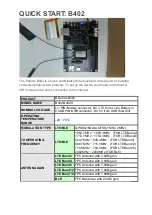
Additional information
20 of 31
Revision 4.0
2021-10-11
Recommendations for board assembly of Infineon transistor outline
type packages
Mounting of through-hole devices
Heat sink screw mounting
Screw mounting is a traditional assembly method using a screw, nut and washer, following these guidelines:
Self-tapping screws should not be used.
It is recommended that a plane washer is inserted between the screw head and the mounting tab. Care must
be taken to ensure that the washer does not damage the plastic body of the package during the mounting
process.
The screw should be properly tightened in a controlled process to ensure that the package makes good contact
with the heat sink.
illustrates the correct mounting components for a TO220 and a TO220 FullPAK. The same concept is
applicable to TO247 packages.
Figure 13
Screw-mounting concept, examples TO220 (left) and TO220 FullPAK (right).
Table 1
Package specific screw mounting concepts. The concepts are independent from the
number of leads of the respective package.
Package
Insulator
Thermal grease
Insulating bushing Washer
TO220
Yes
No
Yes
Yes
TO220 FullPAK
No
Yes
No
Yes
TO247
Yes
No
Yes
Yes
TO247 Advanced
Isolation
No
No
No
Yes
Mounting torque
The thermal contact resistance between the two surfaces is maximized by increasing the contact pressure
between the package and its heat sink. Increasing the mounting torque in the fastening screw, or using a clip
with a high spring constant will result in lower contact resistance areas that provide solid conduction heat flow
paths compared to air conduction through the air gap.
Applying the proper mounting torque is the key factor in obtaining an adequate contact pressure along the
contact surfaces of the package and the heat sink to minimize the contact thermal resistance. If the mounting
torque is too low, the contact thermal resistance increases due to poor thermal connection under insufficient
contact pressure. If mounting torque is too high, the package head and mounting tab are deformed so that the
package may be lifted away from the heat sink as shown in
, also increasing the contact thermal












































